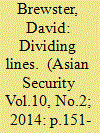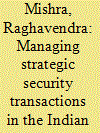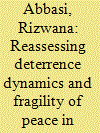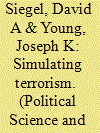|
|
|
Sort Order |
|
|
|
Items / Page
|
|
|
|
|
|
|
| Srl | Item |
| 1 |
ID:
137434


|
|
|
|
|
| Summary/Abstract |
This contribution examines the role of Convergència i Unió and Esquerra Republicana de Catalunya in putting the issue of Catalonia's constitutional relationship with the rest of Spain at the top of the Catalan and Spanish political agenda. It focuses on the strategic behavior of these two parties in pursuit of their territorial goals since 1978 and identifies the complex dynamics that led both parties to converge around a shared commitment to Catalan sovereignty. It is argued that the extent to which past strategic decisions have strengthened or weakened nationalist parties’ credibility on their core business of territorial empowerment has a significant impact on the options currently available to them as they seek a satisfactory answer to the Catalan question.
|
|
|
|
|
|
|
|
|
|
|
|
|
|
|
|
| 2 |
ID:
125566


|
|
|
|
|
| Publication |
2013.
|
| Summary/Abstract |
In this paper, a virtual power market model is proposed to investigate the behavior of power market players from regulator's point of view. In this approach, strategic players are modeled in a multi-agent environment. These agents which are virtual representative of actual players forecast the prices and participate in the markets, exactly the same as real world situation. In addition, the role of ISO is encountered by using security constraint unit commitment (SCUC) and security constraint economic dispatch (SCED) solutions. Moreover, the interaction between market players is modeled using a heuristic dynamic game theory algorithm based on the supply function equilibria (SFE). In addition to the collusive behavior, using the proposed model, the short-term strategic behavior of players, which their effects will appear in long-term, can be simulated.
The proposed model enables the market regulators to make decision before implementing new market rules with the confidence of their results. To represent the effectiveness of the proposed method, a case study including wind power plants is considered and the impact of various market rules on players' behavior is simulated and discussed. Numerical studies indicate that simulating the strategic and collusive behavior prior to any change in the market rules is necessary.
|
|
|
|
|
|
|
|
|
|
|
|
|
|
|
|
| 3 |
ID:
133091


|
|
|
|
|
| Publication |
2014.
|
| Summary/Abstract |
Our mental maps of the world, including our perceptions of where regions begin and end, can have profound consequences on strategic behavior. For decades there has been a sharp division between what we understand to be the regions of South Asia and Southeast Asia. The line between them effectively cuts the Bay of Bengal in two. These perceptions have inhibited a proper analysis of the strategic dynamics of the area. This article argues that the Bay of Bengal increasingly matters as a strategic space. Like, the South China Sea, security issues in the Bay of Bengal and its littoral states need to be understood and addressed in a coherent manner.
|
|
|
|
|
|
|
|
|
|
|
|
|
|
|
|
| 4 |
ID:
161525


|
|
|
|
|
| Summary/Abstract |
This article contributes to an explanation of why Poland, after a period of almost two years’ hesitation, decided to dispatch military forces to the United States-led coalition against the Islamic State in June 2016. The Polish case is examined by applying the concept of strategic culture, taking into account a state’s core military strategic beliefs and the historical experiences on which these beliefs are based. The case study shows that strategic culture shaped the Polish decision-making on the coalition, by predisposing the decision-makers toward a typical Polish behavior in international military operations, namely to exchange security benefits with important allies. The article also has implications for the general study of strategic culture, by specifying the relationship between historical experiences and strategic culture.
|
|
|
|
|
|
|
|
|
|
|
|
|
|
|
|
| 5 |
ID:
190432


|
|
|
|
|
| Summary/Abstract |
Why have Israel and the Palestinians failed to implement a ‘land for peace’ solution, along the lines of the Oslo Accords? This paper studies the application of strategic behavior models, in the form of games, to this question. I show that existing models of the conflict largely rely on unrealistic assumptions about what the main actors are trying to achieve. Specifically, they assume that Israel is strategically interested in withdrawing from the occupied territories pending resolvable security concerns but that it is obstructed from doing so by violent Palestinians with other objectives. I use historical analysis along with bargaining theory to shed doubt on this assumption and to argue that the persistence of conflict has been aligned with, not contrary to, the interests of the militarily powerful party, Israel. The analysis helps explain, from a strategic behavior perspective, why resolutions like the Oslo Accords, which rely on the land for peace paradigm and on self-enforcement, have failed to create peace.
|
|
|
|
|
|
|
|
|
|
|
|
|
|
|
|
| 6 |
ID:
127908


|
|
|
|
|
| Publication |
2014.
|
| Summary/Abstract |
We seek to evaluate the extent of the pass through of increased fuel and carbon costs to wholesale prices with a shift of generation from coal-fired to gas-fired plants. Modelling of Australia's National Electricity Market in 2035 is undertaken using Australian Energy Market Operator assumptions for fuel costs, capital costs and demand forecasts. An electricity market simulation package (PLEXOS), which uses deterministic linear programming techniques and transmission and generating plant data, is used to optimize the power system and determine the least cost dispatch of generating resources to meet a given demand. We find that wholesale market prices increase due to the full pass through of the increased costs of gas over coal as an input fuel and the Carbon Price. In addition, we find that wholesale prices increase by more than the pass through of fuel and carbon costs because of the fact that generators can charge infra-marginal rents and engage in strategic behaviour to maximize their profits.
|
|
|
|
|
|
|
|
|
|
|
|
|
|
|
|
| 7 |
ID:
133675


|
|
|
|
|
| Publication |
2014.
|
| Summary/Abstract |
The Indian Ocean Region (IOR) presents a unique tapestry of correspondences and divergences, positive and negatives, in an era of flux with world order, most likely, on the cusp of a systemic reordering. The geo-strategic salience of this region, as part of a larger global maritime continuum, has also increased. Strategic hedging behaviour by major stakeholders, resident and non-resident alike; besides securitisation of geo-political discourse that focuses on competitive aspects also present distinctive challenges for evolving a cooperative framework tailored to regional needs. The key issues examined for obtaining a pan-regional politico-strategic rapprochement are the tenets of critical geopolitics, game theory, geography, context and the efficacy of existing multilateral mechanisms, especially Indian Ocean Rim Association (IORA). The overall aim is to examine the various intertwined threads for formulating an inclusive and multi-sectoral maritime security framework with an IOR contextualisation.
|
|
|
|
|
|
|
|
|
|
|
|
|
|
|
|
| 8 |
ID:
147397


|
|
|
|
|
| Summary/Abstract |
This study reassesses conflicting strategic behavior of India and Pakistan in the changed regional environment. It predominantly focuses on evaluating the two states’ behavior in regard to their nuclear doctrines, strategies, force postures and, operational plans and their impact on deterrence stability/instability. It continues by examining the following questions: Why do these states behave distinctly on their strategic goals that make peace precarious and deterrence unstable? How far have the changing security dynamics and emerging doctrinal structures of these states made regional deterrence more or less stable? How can these states stabilize deterrence and secure regional peace? The paper finds that nuclear deterrence in South Asia apparently has stabilized the region but the peace was precariously maintained because the two states have distinct strategic direction and goals. India and Pakistan cannot avoid serious and unavoidable risks of nuclear war until they lay down their all-inclusive military plans, adopt budgetary constraints, institute an arms control mechanism and build a stable political relationship.
|
|
|
|
|
|
|
|
|
|
|
|
|
|
|
|
| 9 |
ID:
098249


|
|
|
|
|
| Publication |
2009.
|
| Summary/Abstract |
We present two simulations designed to convey the strategic nature of terrorism and counterterrorism. The first is a simulated hostage crisis, designed primarily to illustrate the concepts of credible commitment and costly signaling. The second explores high-level decision making of both a terrorist group and the state, and is designed to highlight scarce-resource allocation and organizational dynamics. The simulations should be useful both in a traditional classroom setting as well as to the larger public. We provide a primer on the subject matter, and all the material necessary to run the simulations.
|
|
|
|
|
|
|
|
|
|
|
|
|
|
|
|
|
|
|
|
|